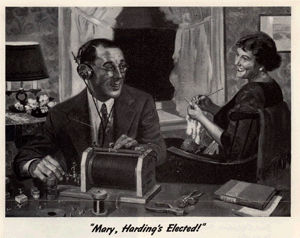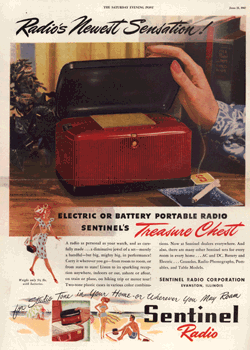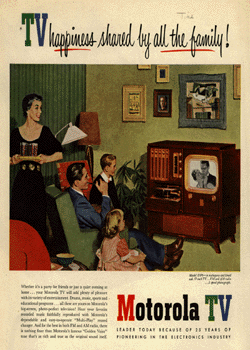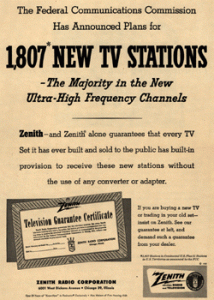Radio & TV
Subcategories
Specialized subcategories for Radio and Television are listed below. The main Radio and Television categories are otherwise subdivided by dates.
Searching under the primary Radio or Television category will always ensure complete listings of all ads in that category, including the subcategories listed below. These subcategories provide more narrow searching for selected topics within those categories.
The original Radio and Television categories created within the “Competitive Advertisements” file at J. Walter Thompson Company consistently included various electronics advertisements, for such items as radio tubes, telephones, radar, etc. The primary companies producing these electronics ads were radio and television companies. Therefore, to reflect the original content of the Radio and Television categories, these specialized subcategories are included.
- Radio Tubes advertisements
- Telephone advertisements
- Miscellaneous electronics advertisements (1922 – 1956)
- Radio War advertisements | Electronics in War advertisements (1940 – 1945)
Brief History of the Radio Industry
 KDKA in Pittsburgh was one of the first radio station in the United States, broadcasting the winner of the Harding – Cox presidential election in 1920 [under the call letters 8ZZ]. By 1922 there were over 500 licensed stations operating in America, but less than 2 million homes equipped with radios. The 1920s and ’30s saw an increased emphasis on the improvement of radio technology, moving away from the head sets and wet/dry battery power to include speakers, AC power and with the radio enclosed in a cabinet. Stations worked to develop increases in frequency distance, strength and power as well as experimenting with ways to lower the prevalence of unwanted background sounds and static.
KDKA in Pittsburgh was one of the first radio station in the United States, broadcasting the winner of the Harding – Cox presidential election in 1920 [under the call letters 8ZZ]. By 1922 there were over 500 licensed stations operating in America, but less than 2 million homes equipped with radios. The 1920s and ’30s saw an increased emphasis on the improvement of radio technology, moving away from the head sets and wet/dry battery power to include speakers, AC power and with the radio enclosed in a cabinet. Stations worked to develop increases in frequency distance, strength and power as well as experimenting with ways to lower the prevalence of unwanted background sounds and static.
 The concept of creating networks, where stations would form chains to simultaneously broadcast programs, was created during the mid-1920s. In 1926, the National Broadcasting Company (NBC) was formed under the auspices of its parent company, Radio Corporation of America (RCA), with two networks of 24 stations. By 1928, a third network was introduced, Columbia Broadcasting Systems (CBS) with 16 stations.
The concept of creating networks, where stations would form chains to simultaneously broadcast programs, was created during the mid-1920s. In 1926, the National Broadcasting Company (NBC) was formed under the auspices of its parent company, Radio Corporation of America (RCA), with two networks of 24 stations. By 1928, a third network was introduced, Columbia Broadcasting Systems (CBS) with 16 stations.
The Depression had a major impact on the number of radio listeners. The cost of radios became more affordable with the sale of table-top models, and the radio provided free entertainment in a period of economic hardship. Programming had become more developed, and news, dramas and comedy were becoming standards on all the stations. By 1939 there were 1,465 stations in the United States and four networks. At the start of the 1940s, the number of households owning a radio had more than doubled.
Government involvement in the radio industry began with the formation of the Federal Communications Commission (FCC) in 1934. The FCC was given the power to grant licenses and enforce legislation relating to ownership practices, radio frequencies, and broadcast programming restrictions. The FCC regulated power usage by radio stations during World War II and prevented the establishment of new stations during that time.
 By the end of WWII, 95% of all homes had radios, but by the early 1950s television already had begun to erode its popularity. Radio stations began to shift their programming focus from news and story segments to mostly music. The introduction of the transistor radio was able to positively impact radio growth in the face of the threat of television by allowing for the production of cheap, portable radios that could be used in cars or outdoors.
By the end of WWII, 95% of all homes had radios, but by the early 1950s television already had begun to erode its popularity. Radio stations began to shift their programming focus from news and story segments to mostly music. The introduction of the transistor radio was able to positively impact radio growth in the face of the threat of television by allowing for the production of cheap, portable radios that could be used in cars or outdoors.
The growth of rock and roll as a popular music form, as well as access to transistor radios by youth, helped stations to flourish in the 1950s and 1960s. The 1970s and ’80s saw the increasing popularity of FM stations because of better sound quality and innovative music programming. With FM’s success, AM stations focused more on talk and news radio, and saw a continuing decline in listenership.
Research and text by Lydia Boyd
Bibliography:
- Bensman, Marvin R. Radio Archive of The University of Memphis: The History of Broadcasting, 1920-1960. www.people.memphis.edu/~mbensman/history1.html
- Heil, Scott and Terrance W. Peck, eds. The Encyclopedia of American Industry, 2nd ed. Detroit: Gale Research, 1998.
- Mishkind, Barry. Who’s on First. www.oldradio.com/archives/general/first.html
- White, Thomas. United States Early Radio History. www.ipass.net/~whitetho/index.html
Brief History of the Television Industry
 Television technology was actually first developed in the 19th century, before commercial radio was conceived of, when, in 1897, Ferdinand Braun invented the cathode ray tube. The first time the cathode ray tube was used to produce images was in 1907. The tube was an essential step in the invention of television, followed by Philo Farnsworth and Vladimir Zworykin’s independent developments of the image dissector and iconoscope. By the end of the 1920s, the United States had a total of fifteen experimental stations for mechanical television. In 1929, Herbert Hoover, at the time the Secretary of Commerce, made an appearance on the mechanical television of AT&T. RCA, the pioneer in broadcast development, did broadcasting experiments in the early 1930s.
Television technology was actually first developed in the 19th century, before commercial radio was conceived of, when, in 1897, Ferdinand Braun invented the cathode ray tube. The first time the cathode ray tube was used to produce images was in 1907. The tube was an essential step in the invention of television, followed by Philo Farnsworth and Vladimir Zworykin’s independent developments of the image dissector and iconoscope. By the end of the 1920s, the United States had a total of fifteen experimental stations for mechanical television. In 1929, Herbert Hoover, at the time the Secretary of Commerce, made an appearance on the mechanical television of AT&T. RCA, the pioneer in broadcast development, did broadcasting experiments in the early 1930s.
On the eve of World War II, RCA was pushing for its television standards to be accepted for production. In response, the National Television System Committee, created by the Federal Communications Commission (FCC) and composed of engineers, made recommendations for electronic television system standards. These were adopted in the spring of 1941. World War II delayed the commercial development of the television, although research and development targeted for the war effort resulted in the possibility of better products for consumers. At the close of World War II, there were less than 7,000 working television sets, and only nine stations on the air, in the entire country. The United States was the leader in television technology, primarily because advances were made directly before, during and after WWII, when America’s major competitors in television development, Germany and England, halted their research programs.
The earliest television networks in the United States (NBC, CBS, ABC and DuMont) were actually part of the larger radio network systems, and many of the early television shows were simulcasts of popular radio shows. In 1951, ABC merged with United Paramount Theaters, gaining sizable financial resources with which to compete in a fierce television market. DuMont was unable to survive and by 1956 was no longer viable, with ABC picking up many of DuMont’s affiliate stations. Networks offered centralized sales, distribution and production services which lowered costs for individual affiliates. This system was geared towards generating advertising revenue as well, because advertisers were interested in the ability to reach nationwide audiences.
During the first five years of the 1950s, ownership of televisions skyrocketed, affecting other forms of entertainment available to the public. This time period witnessed, for example, the closing of many movie theaters, as motion pictures competed with television for consumer attention.
 Ultrahigh Frequency (UHF) channels were unveiled in 1952, after a 1948 freeze on station licensing. The four years allowed engineers to work out the electronic and political complexities of these additional channels. 1962 was the first year that tuners for both UHF and the earlier Very High Frequency (VHF) stations were required by Congress, which allowed UHF stations to compete more effectively. Their position was furthered strengthened in the 1970s with the rise of interest in cable television.
Ultrahigh Frequency (UHF) channels were unveiled in 1952, after a 1948 freeze on station licensing. The four years allowed engineers to work out the electronic and political complexities of these additional channels. 1962 was the first year that tuners for both UHF and the earlier Very High Frequency (VHF) stations were required by Congress, which allowed UHF stations to compete more effectively. Their position was furthered strengthened in the 1970s with the rise of interest in cable television.
In the early years of television, losses were common in the industry due to the high costs involved and the relatively low number of sets owned in the U.S.. Profits grew as the market expanded, though, and the size of the network market peaked in 1986. At that time, competition from cable TV, Pay Per View TV and VCRs began to heavily cut into market share. The big three broadcast networks had a 91% share of prime time audiences during the 1978/9 season. This dropped to 75% in the 1986/7 season, and further to 61% in 1993/4.
Cable TV was developed very early on and began to be used in the 1950s as a way to expand the reach of network television in areas that had problems receiving broadcast signals, prompted by the desire of businesses to sell televisions in their area. In the 1960s cable stations began to import alternative broadcasts into new markets, fragmenting network reach. The networks demanded FCC regulation of the industry and this regulation slowed growth until the 1970s, when cable TV saw phenomenal growth.
Research and text by Lydia Boyd
Bibliography:
- Advertising Age. “History of Television Advertising.” adage.com/
(unavailable as of 2004) - Heil, Scott and Terrance W. Peck, eds. The Encyclopedia of American Industry, 2nd ed. Detroit: Gale Research, 1998.
- Steingberg, Cobbett S. TV Facts. New York: Facts on File, 1980.
- The Media History Project Connections Pages: Television. http://www.mediahistory.umn.edu/teevee.html
- Walker, James Robert and Douglas A. Ferguson. The Broadcast Television Industry. Boston: Allyn and Bacon, 1998.

